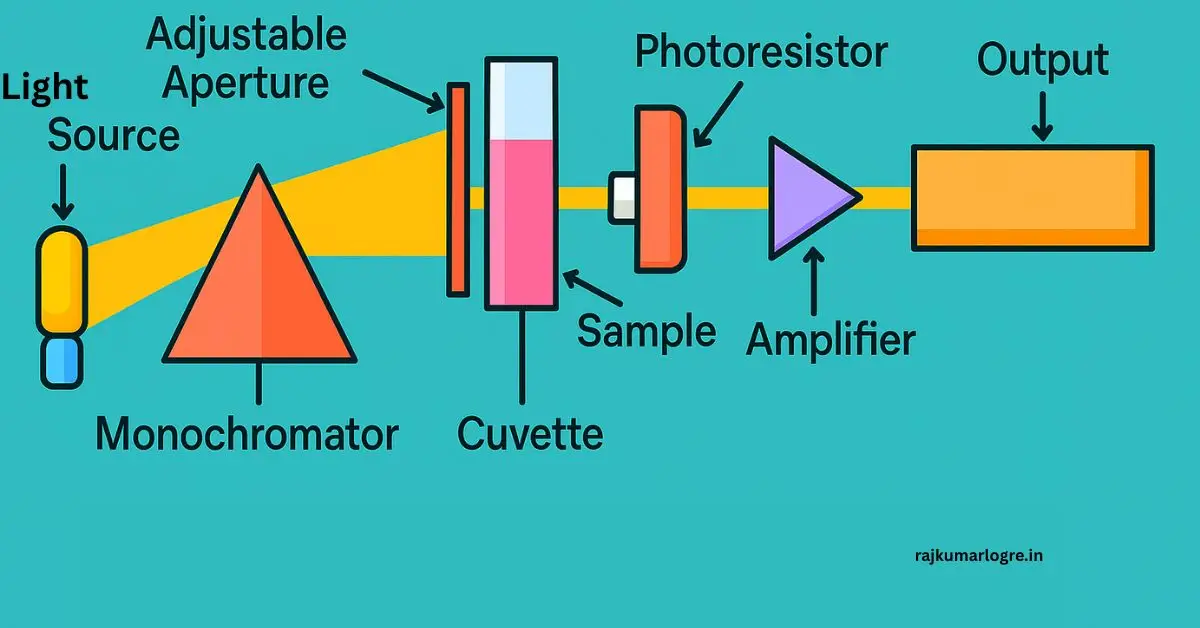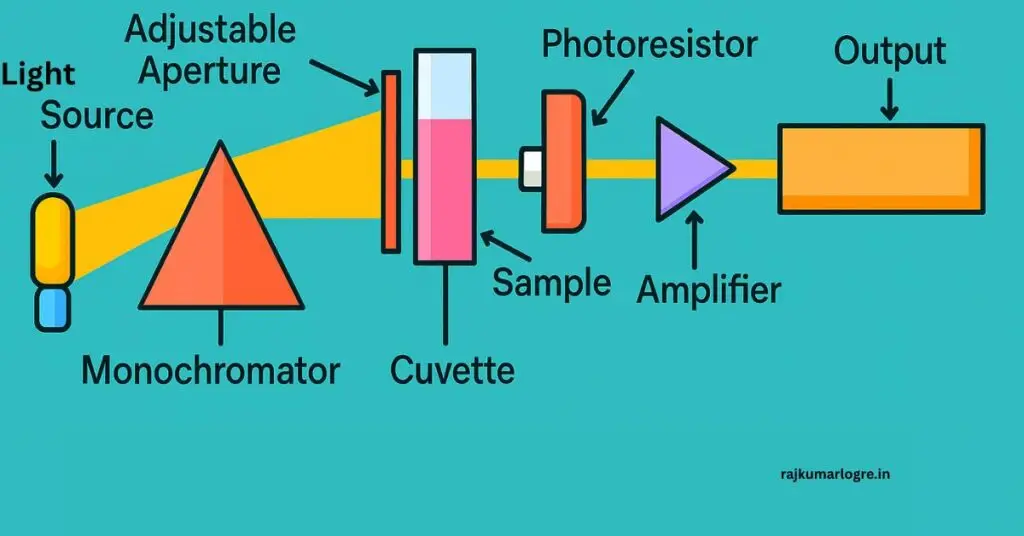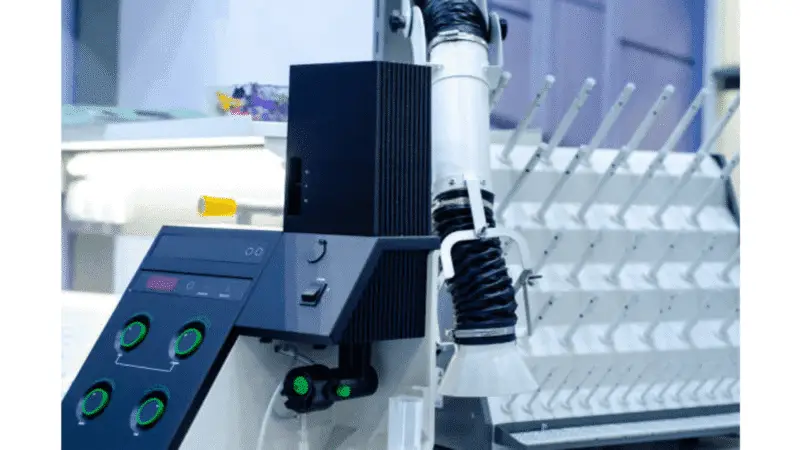Colorimeter: Principle, Components, Types & Applications

Introduction
One essential piece of analytical equipment for figuring out how much of a solution contains colorful compounds is a colorimeter. Based on Beer-Lambert’s Law, a colorimeter measures the absorbance of specific wavelengths of light by a solution to estimate solute concentration. Widely utilized in chemistry, biology, environmental science, food testing, medical diagnostics, and even the cosmetics industry, the colorimeter is a versatile tool in modern laboratories.
What is a Colorimeter?
A scientific tool called a colorimeter is used to quantify how much electromagnetic radiation at a certain wavelength is absorbed by an acidic solution. The device uses a light source, a monochromatic filter, and a photodetector to quantify how much light is absorbed versus transmitted through the sample.
➡️ Key Function: The more concentrated the solution, the more light it absorbs, and less light reaches the detector — allowing for accurate calculation of solute concentration.
Principle of Colorimetry: Beer-Lambert’s Law
The working principle of a colorimeter is based on Beer-Lambert’s Law, which is represented by:
A = εcl
Where:
- A = Absorbance
- ε = Molar absorptivity (L mol⁻¹ cm⁻¹)
- c = Concentration of the solution (mol/L)
- l = Path length of the cuvette (cm)
This rule makes absorbance perfect for utilizing calibration curves to quantify unknown concentrations since it is exactly proportional to both the route length and the solution’s concentration.
Components of a Colorimeter

A typical colorimeter includes the following essential components:
- Light Source
- frequently a visible light source, such an LED or tungsten bulb.
- Monochromatic Filter
- Filters out specific wavelengths suitable for the sample.
- Cuvette (Sample Holder)
- Transparent container for the test solution.
- Photodetector
- Detects transmitted light and converts it into an electrical signal.
- Display Panel or Output Unit
- Shows absorbance or transmittance values.
Types of Colorimeters
Colorimeters come in various types based on their features and applications:
1. Visual Colorimeters
- Operated manually using color comparison discs.
- Outdated and less accurate.
2. Digital Colorimeters
- Use sensors and microprocessors for accurate, fast readings.
- Often include USB/Bluetooth connectivity for data transfer.
3. Portable or Handheld Colorimeters
- Lightweight and easy to carry.
- Used in agriculture, environmental surveys, and fieldwork.
4. Benchtop Colorimeters
- Larger, more accurate, and lab-based.
- Commonly used in industrial quality control and chemical analysis.
Applications of a Colorimeter
Numerous scientific and industrial domains make extensive use of colorimeters. Some major applications of colorimetry include:
1. Clinical Laboratories
- Used to measure glucose, hemoglobin, cholesterol in blood and urine.
- Helps diagnose diabetes, anemia, liver and kidney disorders.
2. Environmental Monitoring
- finds impurities in water, such as heavy metals, phosphates, and nitrates.
- Helps maintain water quality and ecological balance.
3. Food & Beverage Industry
- Measures color consistency and additive concentration in processed foods.
- Used for quality assurance and nutritional testing.
4. Chemical and Educational Laboratories
- Used to determine the concentration of unknown solutions.
- Essential for chemistry and biology practicals in schools and universities.
5. Cosmetic Industry
- Matches and standardizes skin tones in creams and foundations.
- Ensures product uniformity and consumer satisfaction.
6. Textile and Paint Industry
- Ensures uniform dye application on fabrics.
- Maintains consistent paint color shades in manufacturing processes.
Advantages of Using a Colorimeter
✅ Fast Analysis – Delivers real-time results
✅ High Accuracy – Especially in digital versions
✅ User-Friendly – Simple operation, suitable for beginners
✅ Non-Destructive Testing – Samples can be reused
✅ Portable Models Available – Ideal for on-site testing
Limitations of a Colorimeter
❌ Only for Colored Solutions – Can’t analyze colorless compounds
❌ Interference Risk – Other compounds may affect readings
❌ Requires Calibration – Frequent calibration needed for accuracy
❌ Limited Wavelength Range – Typically restricted to visible light only
Colorimeter vs Spectrophotometer: Key Differences
| Feature | Colorimeter | Spectrophotometer |
|---|---|---|
| Light Range | Visible (400–700 nm) | UV, Visible, and IR |
| Accuracy | Moderate | High |
| Cost | Budget-friendly | More expensive |
| Applications | Basic solution analysis | Advanced scientific research |
| Filter Mechanism | Uses simple filters | Uses monochromators/gratings |
Conclusion
The colorimeter remains a vital instrument in analytical chemistry and applied sciences. Its simple yet effective working principle, coupled with modern digital enhancements, has made it invaluable for researchers, technicians, and students alike. Whether it’s measuring blood glucose, analyzing food quality, or monitoring environmental pollutants, colorimetry offers a reliable, accurate, and affordable solution.
As technological advancements continue, digital and portable colorimeters are expanding their scope, contributing significantly to research, education, industry, and environmental sustainability.






